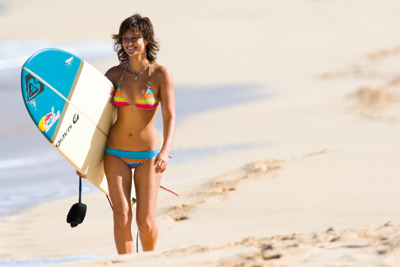
Words by Sam Bleakley
Piano rolling, sax, bass and drums in synch, the trumpet sets loose on a snaking improvisation. The timing is perfect, syncopated, just behind the beat: invention, not imitation. If the pulse of jazz is the ocean swell, then the trumpeter is the longboard surfer improvising against that backdrop, not by stating the obvious, but by creating space through style. Good longboard surfing on 9 feet boards is a mirror of good jazz – the pauses, the tones, the beats, the walk. Most importantly, don’t get fussy – understatement with precise timing always beats flashy overstatement. Smooth flowing longboarders like Californians Joel Tudor and Kassia Meador do not just play the tune straight, but hint at it with sideways glances, subtle intonations, moves away from the beat, long arcing silences punctuated by perfectly timed clusters of blue notes, or just a single shimmering note suspended in space, like hanging ten.
Nose riding is what sets longboarding apart from other forms of surfing. It involves walking up the board in crossed steps to hang five, or role all five toes over the front of the board. The ‘hang ten’ is the defining dance, the finest statement of balance. Similar to riding the tube, time on the nose seems to expand and happen in slow motion. “Noseriding gives you a perfect sensation of weightlessness,” says Australian pro Belinda ‘Bindy’ Baggs. “It reminds me of how a bird rides the back draft of the wind, gliding.”

Bindy and Kassia have been at the forefront of the most stylish movement in contemporary surfing – women’s longboarding. The UK has followed suit, embodied by national longboard champion Grace Davies, from Jersey. As a backlash to the twitchy rock and roll of shortboards, the glide of longboards allow female surfers to be more feminine, flowing with the wave, rather than battling against it and emulating aggressive shortboard moves. The beauty rests in making hard things look easy, linking turns and footwork gracefully. Learning on longboards is considerably easier than short boards because they are more buoyant and stable, making catching waves and balancing easier. But mastering the cross-stepping walk and noseride is just as challenging and rewarding as mastering the shortboard aerial.
Noseriding was invented in 1950s California when all boards were long, and perfected at the long peeling point break of Malibu by Mickey ‘Da Cat’ Dora and Lance Carson. But it was Hawaii-California transplant David Nuuhiwa who took nose riding to its zenith with a grace unmatched until Joel Tudor cat-walked in the 1990s. Nuuhiwa might have won the 1966 World Championships had it not been for Nat ‘The Animal’ Young. The Australian blew everyone away with his aggressive style, carving ‘S’ turns on a revolutionary shorter surfboard. It was a lesson in the future of surfing and heralded the shortboard era. Between 1967 and 1970 while minds expanded, boards contracted from 10 to 6 feet.
The total domination of the hard-to-learn-on shortboard meant the number of new people coming in to surfing slumped. The sport had become quite an elite pastime. Then in the mid 1980s the smoother-riding longboards started to make a return. Strangely, the original shortboard proponent, Nat Young, was at the forefront, this time promoting a fun and fresh style of surfing that was more about using the wave, rather than dominating it. Surfboard shapers were encouraged to perfect a plethora of mid sized boards between 7 and 9 feet, ideal for beginners. Coupled with the growth of the surf school concept, surfing began to boom.
By the 1990s the ‘Longboard Renaissance’ was in full flight. When blonde Californian teenager Joel Tudor was caught on celluloid curling ten toes over the nose surfing’s retro revival was suddenly a hell of a lot more cool. Tudor had the talent and bravado to reformulate the historical references into a unique futuristic style. He was driven to create an artform concentrating on all things longboarding was founded on – nose riding, footwork, trim and smooth style. Before Tudor went on to become a double World Champion he toured Europe with Nat Young and clothing sponsor Oxbow. This inspired charismatic Cornish longboarder Robert ‘Minnow’ Green to start the British Longboard Union contest tour in the mid 1990s. The BLU has created a host of pro longboarders and European Champions, including Chris ‘Guts’ Griffiths and Elliot Dudley from Wales, Will Eastham and Ben Skinner from Newquay and Sam Bleakley from Sennen.

Longboarding is perfectly suited to the small but consistent waves that skirt our cool water coastline, and there are thriving longboard scenes at Saunton and Bantham in Devon and Sennen in Cornwall. Longboarding suits everyone. This is why it’s surfing’s jazz – there are no fixed rules – it’s freeform and expressive. It can be an easy-to-ride reminder of a lost golden era, a minimalist-learning tool for beginners, or a stylish expression for accomplished riders. Longboarding now accounts for half the global surf population, helping to make the line-up way more democratic and unisex.
Minnow has also given a huge amount of energy to raise the profile of the Ladies’ Division at BLU events. Champions Dominique Kent, Louise West, Juliet Marlow, Emma Fitzhenry, Nina Blake, Grace Davies, Candice O’Donnell and Sophie Skinner have been at the heart. “Most people’s opinion of longboarding is that it’s graceful and traditional,” says Cornish lifeguard Louise West. “This is true, but with the variety of board shapes available nowadays, longboarding can be just as progressive and aggressive as shortboarding. When old and new styles are fused together longboarding becomes an extremely exciting and radical sport to participate in and watch.”

Longboard contests, such as the Roxy Jam, promote the more radical style of progressive surfing where nose riding is mixed with big turns. Although inherently anti-competitive these surfers have taken nose riding to new and extreme levels. Their measured walking matches their poise on the nose, never hesitating, always confident they can pull off a variety of hang five and hang tens. The allure of noseriding makes it surfing’s most enduring trick, having taxed surfers for over 50 years.
Before you can ride the nose you must master cross stepping. This is a totally functional way to speed up or slow down your board. Walking is all about overcoming the fear factor and taking your first steps. Lift your back foot over the front in small, soft paces to progress up and down the board. Practice on land or on a long skateboard. Walk – don’t shuffle. Once you can walk, the easiest way to achieve a nose ride is to use the stall. Applying pressure on the back foot to slow down allows the wave to get very steep around you and gets water over the board to hold it and the fin in place – walk to the nose and hang. If you’ve hung five you’ve mastered the Zen paradox of noseriding – applying weight, remaining weightless. If you didn’t get Zen this time, don’t give up – practice. Just watch those clips of Bindy and Kassia. Don’t they look the part?

Pro Views
The planet’s leading longboarders on why they love it so much…
Kassia Meador, RoxyWhat do you love about longboarding?
I love the glide and flow. You don’t have to pump or anything for speed you can just let the energy of the wave move you along. It’s the best feeling ever.
Does it suit girls better than guys?
Men are amazing, but I do think longboarding suits women really well. There’s a certain feminine flow about it that is so graceful and beautiful, like poetry in motion.
What tips do you have for beginners?
Just get out there, don’t get frustrated and give up. Surfing is one of the hardest things in the world to do, and you’re not going to be great over night.
What’s your favourite trick?
Hanging heels. It just feels really good hanging 10 and doing that backwards feels even better.
What kind of waves suit longboarding best?
A shoulder high peeling point break with a good pocket.
Where are the best beaches to longboard?
Malibu, Noosa, San Onofre, The Pass, Cardiff, and all of the cobble stone point breaks in Mexico.
 Jen Smith, Roxy
Jen Smith, Roxy
What do you love about longboarding?
The different styles. Some people have classic styles but I prefer high performance longboarding. I ride a light, thin board because I surf a lot of beach breaks, but if the waves are right for “logging” (point breaks) I love nothing more than to take out a nice heavy single fin and cruise and work on my footwork and noseriding.
Does it suit girls better than guys?
There is something about longboarding that definitely suits a girl. Girls can ride longboards well and look very feminine doing it. It’s all about grace and style.
What tips do you have for beginners?
Keep your hands on the rails of your board until you have your feet planted on the deck and are stable.
What’s your favourite trick?
A reverse take off, where the object is to take off completely backwards.
What kind of waves suit longboarding best?
A point break or reef is the best wave for any board. I prefer a reef because they usually have a little more power they suit my lighter more modern boards.
Where are the best beaches to longboard?
Malibu and Rincon in California. Noosa heads in Australia.
Justine Dupont, Rip Curl
What do you love about longboarding?
It’s faster to paddle so we surf more waves. The atmosphere during the longboard contests are a lot better too.
Does it suit girls better than guys?
It’s for guys and girls. Even if people think that it’s more for old surfers, beginners and girls, there’s a lot of guys who longboard.
What tips do you have for beginners?
Persist. To get better you have to surf a lot, even if it’s cold and rainy. And sometimes you’ll not have a good session, but the day after it’ll be better.

What’s your favourite trick?
The cut back round house.
What kind of waves suit longboarding best?
All waves. I prefer the middle-size waves, or the big ones. I don’t really like the mini-smooth waves. I love it when I have to charge, to have a huge rise of adrenaline.
Where are the best beaches to longboard?
I loved the waves in Dophin Bay, at Noosa, but I also love the beaches where I live in the South West of France, in Lacanau.
For clips of last year’s Roxy Jam action, click here!
Buying a longboard
Epoxy boards are more durable, lighter and buoyant. Fibreglass boards are more refined, personalised, but more fragile. I prefer epoxy boards and SurfTech is the leading brand, with hundreds to choose from. A board sized 9’ 0” to 9’ 6” with either 1 or 3 fins is a perfect starting point. Look for something that you can fit under your arm and feels light enough to carry. The Roxy 9’ 0” ‘Kassia Meador’ and Hobie 9’ 0” ‘PSD’ models are fantastic all-rounder designs. Some shops offer a SurfTech demo centre where you can try before you buy. The leading longboard SurfTech demo centre in the UK is at Chapel Idne Surf Shop in Sennen Cove – chapelidne.com – In France they have an excellent range of longboards at the Rainbow Surf Shop in Anglet, and Cote des Basques in Biarritz is France’s longboard epicentre.


